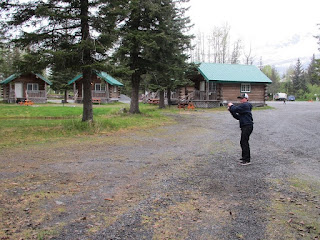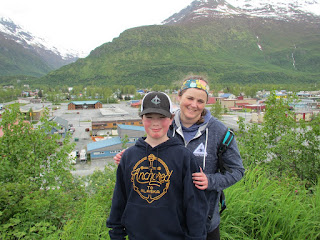
We took the opportunity this weekend for a family road trip to Valdez to drop Landon off at Prince William Sound College. Landon signed up to take a week-long software development college course there this summer. It will be the second college course he's taken so far, he starts his junior year in high school this coming August.

Along the way, we had to stop at one of our favorite restaurants, Long Rifle Lodge, which must have the best view of any restaurant in America. Here's the view out the window from our table, showing the face of the Matanuska Glacier.

Close up of the glacier.

Glacier visible over Landon's shoulder.

After setting a record time in devouring their Glacier Cookie dessert, Grayson gave his regards to the chef.

Long Rifle Lodge.

Worthington Glacier, located near Thompson Pass on the Richardson Highway.

More views of Worthington Glacier.


At the top of Thompson Pass, you'll cross the Trail of 1898. A gold rush era trail, for Klondike Gold Rushers headed North, with horse-drawn sleds pulling their gear. Thompson pass gets nearly 50 feet of snow annually, and has seen as much as 80 feet in one year - the snowiest place in Alaska.

Dueling railroad companies vied for the first route to be blasted through the mountains connecting Prince William Sound to Interior Alaska over 100 years ago. Here is one of the last partially completed tunnels remaining of that effort. A gun battle broke out here between employees of two competing railroad companies, and this route was never finished as a result.

Horse Tail Falls, also along the Richardson Highway to Valdez.

We tent-camped this trip, and stayed at a campground outside of Valdez. Here Grayson gets ready to lob a long pass to me across the campground.

Driving into Valdez.

Landon had to report right to the college, so he didn't get much time with us to view the city. But his class will be touring the city each evening during their weeklong course. Can't beat the view of this campus.

The college's Indian Head....reminds me a little of Tecumseh in T-Court at the Naval Academy.

The Trans Alaska Pipeline parallels the Richardson Highway. Here is Grayson standing next to a replica of the pipeline, with a 'scraper pig' showing in the cutout.

Quick description of the purpose of the 'pig'.

At the entrance to the city's museum, you're greeted by a Fresnel lens, which sat atop Hinchinbrook Lighthouse in Valdez. Built between 1906-1910, the lighthouse was damaged by an earthquake in 1920 and replaced.

Valdez original firefighting equipment.

A 1907 Ahren's Steamer. It arrived in Valdez on the S.S. Yucatan in 1907, and is one of only 105 ever manufactured, of which only 12 remain in existance. If you look closely, you can see the 'siren' (bell) mounted on the front, and the 'headlights' (kerosene lamps) hanging at the sides.

These skis were mounted to the Eaglerock biplane of pilot Owen Meals when he crash-landed at Gakona carrying two passengers. He escaped unhurt, but his two passengers, a photographer and teacher headed to Valdez were both seriously injured. They both survived, and went on to live a long life in Valdez. After the crash, Meals telegraphed his wife, who was visiting family in Amarillo, Texas. His telegraph is below:

Mrs. Meals evidently kept the telegraph, and brought it back to Alaska with her.
It says:
MRS OWEN E. MEALS=
131 WEST FIFTH ROBERTS PLACE, AMARILLO, TEX=
CRASHED SHIP MAKING FORCED LANDING SUNDAY AT GAKONA STOP
I AM NOT HURT DON'T HURRY OR WORRY MUCH LOVE=
OWEN.


A list of early Valdez residents, and gold rushers who passed through. This is the McDowell page....with several McDowells listed, one from Chisna, MD (can't find that town anymore), and another from Mexico, Missouri.

The extremely rare Northern Pacific Fur Fish. Now you can say you've seen one. (wink)

On Good Friday, March 27th 1964, at 5:36 PM, Alaska was rocked by a 9.2 magnitude earthquake centered in Prince William Sound 55 miles west of Valdez. More than 30 people were killed nearly instantly in Valdez, on the pier and city docks, as their supply ship S.S. Chena was docked and being met by townspeople and children. An underwater landslide created a massive tsunami that engulfed the shift, pier and town. The quake remains the largest on record for the United States, and the second largest recorded quake in the world. A sailor on the Chena was recording at the time of the quake, and you can watch the actual footage of the tsunami here:
https://www.youtube.com/watch?v=TdrMKt55VBQ

The town site was devastated, and although many buildings remained, it was determined to be too dangerous to rebuild at that location, and a new town site was chosen a few miles away.

Today, you can walk through the old town site. This is the remains of the pier shown in the above linked video - where many lost their lives immediately as the quake struck, looking out to where the S.S. Chena would have been docked.

At the end of the pier, looking back towards the old town site.

The roads remain, but the buildings were either destroyed or moved to the new town site, and their original locations are now marked with stakes and signs.

Across Southcentral Alaska, the Good Friday Earthquake left massive destruction.

The Pinzon - a local favorite bar in old Valdez. Moved to the museum and reassembled as it looked on its last day of operation, the day of the earthquake.

Oil Boom. In the 70's oil from the North Slope of Alaska, made its way along the ~800 miles of pipeline to a terminal in Valdez, where it was loaded on ships bound for markets around the world. Here in the museum is a replica of a section of pipeline as constructed.

The first barrel of oil delivered to Valdez through the pipeline is displayed in the city.

Workers joined the effort from around the world, personalizing their individual hard hats with their own 'flare'.

You would think that the earthquake was enough disaster for one town, but Valdez had another disaster looming in 1989. On the evening of March 23, 1989, the oil tanker Exxon Valdez left the port of Valdez and headed out of Prince William Sound. Here you can see its path, where it veered off course while attempting to avoid small icebergs believed to be in the area, and ran aground on Bligh Reef on the morning of March 24th, spilling 10.8 million gallons of crude oil into the one of the most pristine natural environments on Earth.

A section of the hull taken from the damaged tanker.

A map showing the dispersal of crude oil along 1,300 miles of coastline. 30 years after the spill, you can still find raw oil under the top layer of rocks along the seashore.

Inside the city, a church sits framed by snow-capped mountains.

I think I can take him!

Wolves, moose, bears displayed at the college's Whitney museum.

Northern Alaska fauna.

While there, we attended the city's free community fish fry that they hold each year. Fried Halibut! Delicious! Thank you, Valdez!

Eating with a view (again), on the city docks of Valdez.

The city of Valdez in the background.

A man with one iPhone ALWAYS knows the temperature. But a man with three iPhones NEVER knows the temperature!!
